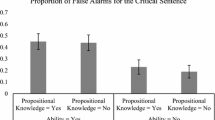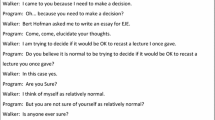Abstract
This paper investigates the dissociation between conscious and unconscious knowledge in an implicit learning paradigm. Two experiments employing the artificial grammar learning task explored the acquisition of unconscious and conscious knowledge of structure (structural knowledge). Structural knowledge was contrasted to knowledge of whether an item has that structure (judgment knowledge). For both structural and judgment knowledge, conscious awareness was assessed using subjective measures. It was found that unconscious structural knowledge could lead to both conscious and unconscious judgment knowledge. When structural knowledge was unconscious, there was no tendency for judgment knowledge to become more conscious over time. Furthermore, conscious rather than unconscious structural knowledge produced more consistent errors in judgments, was facilitated by instructions to search for rules, and after such instructions was harmed by a secondary task. The dissociations validate the use of these subjective measures of conscious awareness.








Similar content being viewed by others
References
Allwood, C. M., Granhag, P. A., & Johansson, H. (2000). Realism in confidence judgements of performance based on implicit learning. European Journal of Cognitive Psychology, 12, 165–188.
Baddeley, A. (1986). Working memory. Oxford: Clarendon.
Block, N. (2001). Paradox and cross purposes in recent work on consciousness. Cognition, 79, 197–219.
Boucher, L., & Dienes, Z. (2003). Two ways of learning associations. Cognitive Science, 27, 807–842.
Chan, C. (1992). Implicit cognitive processes: Theoretical issues and applications in computer systems design. Unpublished doctoral thesis, University of Oxford.
Channon, S., Shanks, D., Johnstone, T., Vakili, K., Chin, J., & Sinclair, E. (2002). Is implicit learning spared in amnesia? Rule abstraction and item familiarity in artificial grammar learning. Neuropsychologia, 40, 2185–2197.
Destrebecqz, A., & Cleeremans, A. (2001). Can sequence learning be implicit? New evidence with the process dissociation procedure. Psychonomic Bulletin & Review, 8, 343–350.
Destrebecqz, A., & Cleeremans, A. (2003). Temporal effects in sequence learning. In L. Jiménez (Ed.), Attention and implicit learning (pp. 181–213). Amsterdam: Benjamins.
Dienes, Z. (2004). Assumptions of subjective measures of unconscious mental states: Higher order thoughts and bias. Journal of Consciousness Studies, 11, 25–45.
Dienes, Z., & Altmann, G. (1997). Transfer of implicit knowledge across domains? How implicit and how abstract? In D. Berry (Ed.), How implicit is implicit learning? (pp. 107–123). Oxford: Oxford University Press.
Dienes Z., & Berry, D. (1997). Implicit synthesis. Psychonomic Bulletin and Review, 4, 68–72.
Dienes, Z., Longuet-Higgins, H. C. (2004). Can musical transformations be implicitly learned? Cognitive Science, 28, 531–558.
Dienes, Z., & Perner, J. (1999). A theory of implicit and explicit knowledge. Behavioural and Brain Sciences, 22, 735–755.
Dienes, Z., & Perner, J. (2003). Unifying consciousness with explicit knowledge. In A. Cleeremans (Ed.), The unity of consciousness: Binding, integration, and dissociation (pp. 214–232). Oxford: Oxford University Press.
Dienes, Z., & Perner, J. (2004). Assumptions of a subjective measure of consciousness: Three mappings. In R. Gennaro (Ed.), Higher order theories of consciousness (pp. 173–199). Amsterdam: Benjamins.
Dienes, Z., Broadbent, D. E., & Berry, D. C. (1991). Implicit and explicit knowledge bases in artificial grammar learning. Journal of Experimental Psychology: Learning, Memory, & Cognition, 17, 875–882.
Dienes, Z., Altmann, G., Kwan, L., & Goode, A. (1995). Unconscious knowledge of artificial grammars is applied strategically. Journal of Experimental Psychology: Learning, Memory, & Cognition, 21, 1322–1338.
Dienes, Z., Kurz, A., Bernhaupt, R., & Perner, J. (1997). Application of implicit knowledge: Deterministic or probabilistic? Psychologica Belgica, 37, 89–112.
Dulany, D. E., Carlson, R. A., & Dewey, G. I. (1984). A case of syntactical learning and judgement: How conscious and how abstract? Journal of Experimental Psychology: General, 113, 541–555.
Frensch, P. A., Wenke, D., & Ruenger, D. (1999). A secondary tone-counting task suppresses expression of knowledge in the serial reaction task. Journal of Experimental Psychology: Learning, Memory, & Cognition, 25, 260–274.
Gardiner, J. M., & Parkin, A. J. (1990). Attention and recollective experience in recognition memory. Memory & Cognition, 18, 579–583.
Gardiner, J. M., Ramponi, C., & Richardson-Klavehn, A. (1998). Experiences of remembering, knowing, and guessing. Consciousness and Cognition, 7, 1–26.
Jacoby, L. L. (1991). A process dissociation framework: Separating automatic from intentional uses of memory. Journal of Memory and Language, 30, 513–541.
Jacoby, L. L., & Hay, J. F. (1998). Age-related deficits in memory: Theory and application. In M. A. Conway (Ed.), Theories of memory II (pp. 111–134). Mahwah, NJ: Erlbaum.
Jiménez, L (Ed.). (2003). Attention and implicit learning. Amsterdam: Benjamins
Kelley, C. M., & Jacoby, L. L. (2000). Recollection and familiarity: Process-dissociation. In E. Tulving, F. I. M. Craik (Eds.), The Oxford handbook of memory (pp. 215–228). Oxford: Oxford University Press.
Kinder, A., Shanks, D. R., Cock, J., & Tunney, R. J. (2003). Analytic and nonanalytic strategies and the explicit/implicit distinction in artificial grammar learning. Journal of Experimental Psychology: General, 132, 551–565.
Lau, K. K. (2002). Metacognitive measures of implicit learning in a dynamic control task. Unpublished doctoral thesis, University of Sussex.
Mathews, R. C. (1997). Is research painting a biased picture of implicit learning? The danger of methodological purity in scientific debate. Psychonomic Bulletin & Review, 4, 38–42.
Mathews, R. C., Buss, R. R., Stanley, W. B., Blanchard-Fields, F., Cho, J. R., & Druhan, B. (1989). The role of implicit and explicit processes in learning from examples: A synergistic effect. Journal of Experimental Psychology: Learning, Memory, and Cognition,15, 1083–1100.
Pacini, R., & Epstein, S. (1999). The relation of rational and experiential information processing styles to personality, basic beliefs, and the ratio-bias phenomenon. Journal of Personality and Social Psychology, 76, 972–987.
Parkin, A. J., Reid, T. K., & Russo, R. (1990). On the differential nature of implicit and explicit memory. Memory & Cognition, 18, 507–514.
Perruchet, P., & Pacteau, C. (1990). Synthetic grammar learning: Implicit rule abstraction or explicit fragmentary knowledge? Journal of Experimental Psychology: General, 119, 264–275.
Perruchet, P., Vinter, A., & Gallego, J. (1997). Implicit learning shapes new conscious percepts and representations. Psychonomic Bulletin & Review, 4, 43–48.
Reber, A. S. (1967). Implicit learning of artificial grammars. Journal of Verbal Learning and Verbal Behaviour, 6, 855–863.
Reber, A. S. (1969). Transfer of syntactic structures in synthetic languages. Journal of Experimental Psychology, 81, 115–119.
Reber, A. S. (1989). Implicit learning and tactic knowledge. Journal of Experimental Psychology: General,118, 219–235.
Reber, A. S., & Allen, R. (1978). Analogic and abstraction strategies in synthetic grammar learning: a functionalist interpretation. Cognition,6, 189–221.
Reber, A. S., Kassin, S.M., Lewis, S., & Cantor, G. (1980). On the relationship between implicit and explicit modes in the learning of a complex rule structure. Journal of Experimental Psychology: Human Learning & Memory, 6, 492–502.
Redington, M., Friend, M., & Chater, N. (1996). Confidence judgements, performance, and practice, in artificial grammar learning. In G. W. Cottrell (Ed.), Proceedings of the Eighteenth Annual Conference of the Cognitive Science Society (pp. 649–654). Mahwah, NJ: Erlbaum.
Roberts, P. L., & MacLeod, C. (1995). Representational consequences of two modes of learning. Quarterly Journal of Experimental Psychology, 48A, 296–319.
Rosenthal, D. M. (1986). Two concepts of consciousness. Philosophical Studies, 49, 329–359.
Rosenthal, D. M. (2005). Consciousness and mind. Oxford: Clarendon.
Rotello, C. M., Macmillan, N. A., & Reeder, J. A. (2004). Sum-difference theory of remembering and knowing: A two-dimensional signal-detection model. Psychological Review, 111, 588–616.
Shanks, D. R. (2003). Attention and awareness in “implicit” sequence learning. In L. Jiménez (Ed.), Attention and implicit learning (pp. 11–42). Amsterdam: Benjamins.
Tunney, R. J. (in press). Sources of confidence judgments in implicit cognition. Psychonomic Bulletin & Review.
Tunney, R. J., & Altmann, G. T. M. (2001). Two modes of transfer in artificial grammar learning. Journal of Experimental Psychology: Learning, Memory, & Cognition, 27, 1322–1333.
Tunney, R. J., & Shanks, D. R. (2003). Subjective measures of awareness and implicit cognition. Memory and Cognition, 31, 1060–1071.
Tymann, P., & Dienes, Z. (2004). Biased metacognitive measurement of implicit knowledge. Manuscript submitted for publication.
Waldron, E. M., & Ashby, F. G. (2001). The effects of concurrent task interference on category learning: Evidence for multiple category learning systems. Psychonomic Bulletin & Review, 8, 168–176.
Whittlesea, B. W. A., & LeBoe, J. P. (2000). The heuristic basis of remembering and classification: Fluency, generation, and resemblance. Journal of Experimental Psychology: General, 129, 84–106.
Wilkinson, L., & Shanks, D. R. (2004). Intentional control and implicit sequence learning. Journal of Experimental Psychology: Learning, Memory, and Cognition, 30, 354–369.
Ziori, E., Dienes, Z. (in press). Subjective measures of unconscious knowledge of concepts. Mind & Society.
Author information
Authors and Affiliations
Corresponding author
Appendix 1
Appendix 1
The training sets include 15 unique strings from the chosen grammar repeated three times in different random orders. The test set includes 30 unique strings from each grammar randomly combined (Table 6).
Rights and permissions
About this article
Cite this article
Dienes, Z., Scott, R. Measuring unconscious knowledge: distinguishing structural knowledge and judgment knowledge. Psychological Research 69, 338–351 (2005). https://doi.org/10.1007/s00426-004-0208-3
Received:
Accepted:
Published:
Issue Date:
DOI: https://doi.org/10.1007/s00426-004-0208-3




